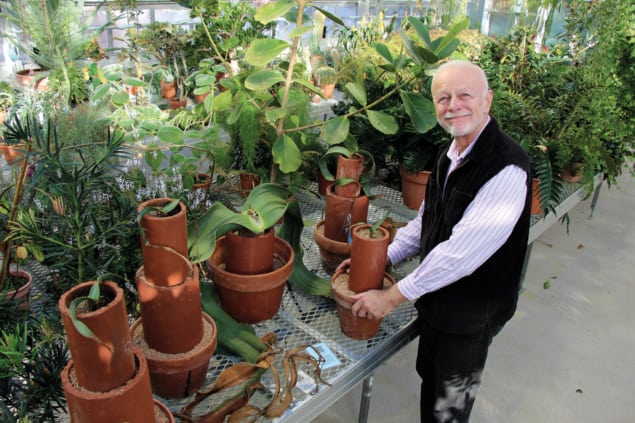Botany may be as valuable for physicists as physics is for botanists, finds Robert P Crease

Karl Niklas got his 15 minutes of fame in 1981. A botanist at Cornell University, he used a wind tunnel to determine if the ancient plants whose fossils he was studying were wind or insect pollinated, and published the findings in Science. Deluged by speaking and writing invitations from colleagues, he was astonished that using a wind tunnel to study plants that had been dead for hundreds of millions of years would create such a buzz.
“Want to know if wind is involved in some process you are studying?” he said when I met him in January. “Get a wind tunnel, stick in something that mimics it, and see what happens. That’s not genius, just common sense.”
His work might be common sense to a quantitatively inclined scientist. But Niklas is unusual among plant biologists. His peers, who are more used to doing experiments in “wet” labs, tend to regard his reliance on mathematical tools and physics equipment as hocus-pocus. To appreciate his work one needs to carry out integrations and solve partial differential equations. Yet the result, as he showed in his far-ranging 2012 co-authored book Plant Physics, demonstrates the value not only of physics for botany, but also of botany for physics.
Niklas, 70, who retires at the end of this year, has occupied the same office on the second floor of the plant-biology building throughout his 40 years at Cornell. Aside from books and fossils, his office also has a cello (played every morning), a rack of pipes (used about once a week), and an old microscope covered with a bell jar to keep out dust. Having originally graduated in mathematics from the City College of New York in Manhattan in 1970, Niklas switched to the University of Illinois at Urbana-Champaign, where he studied plants as part of its graduate programme in paleobiology.
I asked Niklas if it was hard to switch abruptly from mathematics to plants. “Not really,” he said. “Plants are very structural. They are not like animals, with bones and muscles that work like pulleys and levers. They are big bags of chemicals that are displayed structurally to intercept light, deal with gravity, and absorb water and minerals.” Mathematics, he thought, might provide insight into these structures.
For his PhD thesis, Niklas devised a computer model to simulate how cells of ancient plant matter divided, and demonstrated that what botanists thought were three separate species of algae were in fact different stages in the growth of the same species. He moved to Cornell in 1978, where he began his work on pollination.
Model building
Niklas suspected that the earliest plants with seeds would have been pollinated by wind rather than insects, but wanted to make sure. He therefore built models of the ancient seeds and plants, and investigated the fluid mechanics with the aid of a wind tunnel and stroboscope to image the airborne spores. “I could show that the change in seed architecture over time was increasing the efficiency of wind pollination,” he told me.
Soon he experimented on living plants, in work that required him to measure the mechanical properties of their parts. This he did with an Instron, a device that measures the resisting force when you pull, bend or twist a material, allowing you to determine the elastic moduli. The Instron is often used in engineering labs to bend iron bars and crush concrete, but the one in Niklas’ office makes delicate measurements such as of the tensile properties of a human hair.
On one occasion, a graduate student from Spain came to Cornell to study the elastic stretching properties of tomato cuticle – the waxy surface of the fruit that occasionally cracks. Farmers in Spain were losing billions of dollars because if they sold a box of tomatoes with even one cracked tomato, the entire box was returned. “He and I spent the summer at the Instron stretching tomato cuticles, finding why and how they crack, and what you can do so they don’t.”

Rocket for rocketeers
Niklas was for a decade the editor of the American Journal of Botany. Then, in the mid-1990s, he began collaborating with Hanns-Christof Spatz (1936–2017), who had received his PhD in physics from the University of Göttingen but was drawn into biology while quantifying the electrical properties of neurosystems in fruit flies. After writing papers together, they challenged themselves: Could they write a book whose chapters addressed all the basic topics normally covered in a physics course but using plants as examples?
“After a large number of single-malt Scotches, we both agreed that we could.” Plant Physics, which took them two years to write, was the result.
The critical point
Historically, physicists have sometimes used plants as models or objects of study. Galileo based some of the mechanics on his studies of the hollow stalks of grass stems, learning for instance that the outer shell rather than the central matter plays the key role in how structures bend. At the end of the 19th century, the Swiss botanist Simon Schwendener created a new field by applying physics to biological organisms to understand their functional engineering and in 1874 published a book called The Mechanical Principles of the Anatomy of Monocotyledons.
Niklas and Spatz’s book modernizes and extends this work, demonstrating that biological processes still have challenges for physicists. One example is viscoelasticity, the property possessed by substances that are both elastic and viscous. “Unfortunately,” Niklas and Spatz write, “no mechanistic model exists that can fully treat the behaviour of nonlinear viscoelastic materials.”
“Evolution,” Niklas likes to say, “is a long-standing experiment in survival and adaptation in which nature is constantly testing organisms. Organisms either ‘work’ – adapt – or die.” By helping to understand the dynamics, he said, “physics helps you understand why.”



